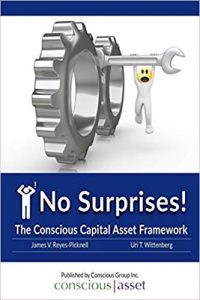
Building a successful and sustained asset management program
Putting the Framework to Work
By: James Reyes-Picknell & Uri Wittenberg. In figure 2 below, it should be clear that The Conscious Asset Framework™ is general in nature. It is what we want to achieve but how do we get there?
Few of us are fans of cookie-cutter, one-size-fits-all, approaches and methodologies. They just don’t work without some sort of tailoring. Some consulting firms have rigid approaches and they won’t vary from them. Others claim to have no approach, but in reality most simply haven’t taken the time to articulate one. Most, including many “experts”, do use some guiding methodology or model even if they can’t (or won’t) describe it clearly.
We’ve done extensive reviews of our client work experience and the extensive literature about major change initiatives – both the good and the bad. From those we’ve learned what does and doesn’t work and from that we’ve come up with a way to maximize our customers’ chances of success.
The Conscious Asset Framework™, comprised of four Sustainability Stages, which within themselves are designed to be highly flexible, addressing and fitting a variety of customer environments.
1. Readiness
Our aim is to ensure full understanding of what the organization’s vision is, what are the expected results and deliverables, and how ready the organization is to embark on a success journey. There is no desire to re-invent any wheels or cover ground you’ve already covered, but we also want to ensure that nothing important was missed.
This realization and early comprehension of possible gaps, provides the opportunity to craft a tailored approach to deliver the desired end results, including all the specific tools and actions needed. A resistance management plan proactively addresses those who are unable or unwilling to adopt the changes. A sponsorship roadmap considers who the sponsors must be and what is expected of them.
Some of the inputs and aids we use include (but are not limited to):
2. Awareness
A communication plan will help ensure the right message is sent from the right sender to the right receiver and at the right time. That plan is developed here.
From the outset of the initiative, awareness sessions will be conducted at various levels of the organization, introducing the basics of Asset Management concepts, as well as highlighting the methodology and steps which are going to be utilized throughout the initiative. Building accurate and comprehensive awareness goes a long way to laying the foundation for successful outcomes and sustainability into the future.
This stage provides for on-going facilitation sessions, concept education and subject matter training classes, will be interwoven into the various stages of deployment. Members of the organization will be invited to those various learning and information sharing events, in close proximity to the time they will require this information of their involvement. Sample learning tools to be considered include:
3. Planning
Each organization is very unique in both its human and physical environment makeup, and will therefore require a very specific journey to get to its destination accordingly.
This stage of the Conscious Asset Framework™ establishes where the “stumbling blocks” and the non-value-added (wasteful) elements are in the present environment. We will aid you in outlining the Blueprint of Success, to include the appropriate team structures and detailed project plans. Some of the tools to be utilized include:
4. Deployment
With the awareness of what the change may entail and the commitment and accountabilities anticipated, the organization is now primed to embark on the execution task. The communication and resistance plans are executed as described in the sponsorship roadmap. We include coaching and training, working with individuals to instill awareness of the change, the reasons for it and management expectations.
In this stage a strict Business Excellence methodology is introduced to include, among other things:
Get the whole story,
No Surprises! The Conscious Capital Asset Framework
If we are to be good at Asset Management we need to understand what it is and what it is not, begin to think of our business more holistically, consider our role as contributing to a greater whole and start behaving differently. Once we’ve achieved that, Asset Management should be sustained – it never stops. Putting it in place is not just a project with a beginning and end although it may start that way. It is really about putting in place a new corporate culture and continually improving it. This book speaks to those changes and how to go about doing it.
~$12 via Amazon

 Ask a question or send along a comment.
Please login to view and use the contact form.
Ask a question or send along a comment.
Please login to view and use the contact form.
Leave a Reply